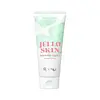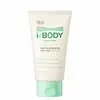What's inside
What's inside
 Key Ingredients
Key Ingredients

 Benefits
Benefits

 Concerns
Concerns

 Ingredients Side-by-side
Ingredients Side-by-side

Water
Skin ConditioningGlycerin
HumectantPropanediol
SolventHydrogenated Poly(C6-14 Olefin)
EmollientNiacinamide
SmoothingPolyglyceryl-6 Distearate
EmulsifyingCetearyl Alcohol
EmollientPropylheptyl Caprylate
EmollientAmmonium Acryloyldimethyltaurate/Vp Copolymer
Candelilla/Jojoba/Rice Bran Polyglyceryl-3 Esters
Emulsifying1,2-Hexanediol
Skin ConditioningVinyldimethicone
Glyceryl Stearate
EmollientMethyl Trimethicone
Skin ConditioningHydroxyacetophenone
AntioxidantDipropylene Glycol
HumectantLaminaria Japonica Extract
Skin ProtectingEclipta Prostrata Leaf Extract
Skin ConditioningCoptis Japonica Root Extract
Skin ConditioningButylene Glycol
HumectantOryza Sativa Bran Oil
EmollientEthylhexylglycerin
Skin ConditioningXanthan Gum
EmulsifyingSodium Stearoyl Glutamate
CleansingFructooligosaccharides
HumectantAdenosine
Skin ConditioningGlyceryl Polymethacrylate
Hydrogenated Lecithin
EmulsifyingBeta-Glucan
Skin ConditioningPanthenol
Skin ConditioningHydrolyzed Hyaluronic Acid
HumectantMaltodextrin
AbsorbentTocopherol
AntioxidantMethylpropanediol
SolventHydrolyzed Gardenia Florida Extract
AntioxidantCeramide NP
Skin ConditioningOpuntia Coccinellifera Fruit Extract
Skin ConditioningPhaseolus Vulgaris Seed Extract
Skin ConditioningWater, Glycerin, Propanediol, Hydrogenated Poly(C6-14 Olefin), Niacinamide, Polyglyceryl-6 Distearate, Cetearyl Alcohol, Propylheptyl Caprylate, Ammonium Acryloyldimethyltaurate/Vp Copolymer, Candelilla/Jojoba/Rice Bran Polyglyceryl-3 Esters, 1,2-Hexanediol, Vinyldimethicone, Glyceryl Stearate, Methyl Trimethicone, Hydroxyacetophenone, Dipropylene Glycol, Laminaria Japonica Extract, Eclipta Prostrata Leaf Extract, Coptis Japonica Root Extract, Butylene Glycol, Oryza Sativa Bran Oil, Ethylhexylglycerin, Xanthan Gum, Sodium Stearoyl Glutamate, Fructooligosaccharides, Adenosine, Glyceryl Polymethacrylate, Hydrogenated Lecithin, Beta-Glucan, Panthenol, Hydrolyzed Hyaluronic Acid, Maltodextrin, Tocopherol, Methylpropanediol, Hydrolyzed Gardenia Florida Extract, Ceramide NP, Opuntia Coccinellifera Fruit Extract, Phaseolus Vulgaris Seed Extract
Water
Skin ConditioningGlycerin
HumectantButylene Glycol
HumectantTriethylhexanoin
MaskingCaprylic/Capric Triglyceride
MaskingCetearyl Alcohol
EmollientPolyglyceryl-3 Methylglucose Distearate
EmulsifyingPentaerythrityl Stearate/Caprate/Caprylate/Adipate
EmollientPanthenol
Skin ConditioningCetearyl Olivate
Butyrospermum Parkii Butter
Skin ConditioningGlyceryl Stearate
EmollientDipentaerythrityl Pentaisononanoate
EmollientStearyl Alcohol
EmollientTrehalose
HumectantGlycine Soja Oil Unsaponifiables
EmollientTriticum Vulgare Germ Oil Unsaponifiables
EmollientOlea Europaea Oil Unsaponifiables
Skin ConditioningArgania Spinosa Kernel Oil
EmollientPollen Extract
EmollientSorbitan Olivate
EmulsifyingCaprylyl Glycol
EmollientCarbomer
Emulsion StabilisingAmmonium Acryloyldimethyltaurate/Beheneth-25 Methacrylate Crosspolymer
Emulsion StabilisingSodium Polyacryloyldimethyl Taurate
Emulsion StabilisingDipropylene Glycol
HumectantCetyl Ethylhexanoate
EmollientHydrogenated Polydecene
EmollientTrisiloxane
Skin ConditioningLactobacillus Ferment Lysate
Skin ConditioningBifida Ferment Lysate
Skin ConditioningStreptococcus Thermophilus Ferment
HumectantEthylhexyl Palmitate
EmollientHydrogenated Lecithin
EmulsifyingDisodium EDTA
Trideceth-10
Cleansing1,2-Hexanediol
Skin ConditioningCholesterol
EmollientHydrolyzed Hyaluronic Acid
HumectantCeramide NP
Skin ConditioningPalmitic Acid
EmollientStearic Acid
CleansingBeta-Glucan
Skin ConditioningEthylhexylglycerin
Skin ConditioningPentylene Glycol
Skin ConditioningHydroxyacetophenone
AntioxidantTocopherol
AntioxidantTromethamine
BufferingWater, Glycerin, Butylene Glycol, Triethylhexanoin, Caprylic/Capric Triglyceride, Cetearyl Alcohol, Polyglyceryl-3 Methylglucose Distearate, Pentaerythrityl Stearate/Caprate/Caprylate/Adipate, Panthenol, Cetearyl Olivate, Butyrospermum Parkii Butter, Glyceryl Stearate, Dipentaerythrityl Pentaisononanoate, Stearyl Alcohol, Trehalose, Glycine Soja Oil Unsaponifiables, Triticum Vulgare Germ Oil Unsaponifiables, Olea Europaea Oil Unsaponifiables, Argania Spinosa Kernel Oil, Pollen Extract, Sorbitan Olivate, Caprylyl Glycol, Carbomer, Ammonium Acryloyldimethyltaurate/Beheneth-25 Methacrylate Crosspolymer, Sodium Polyacryloyldimethyl Taurate, Dipropylene Glycol, Cetyl Ethylhexanoate, Hydrogenated Polydecene, Trisiloxane, Lactobacillus Ferment Lysate, Bifida Ferment Lysate, Streptococcus Thermophilus Ferment, Ethylhexyl Palmitate, Hydrogenated Lecithin, Disodium EDTA, Trideceth-10, 1,2-Hexanediol, Cholesterol, Hydrolyzed Hyaluronic Acid, Ceramide NP, Palmitic Acid, Stearic Acid, Beta-Glucan, Ethylhexylglycerin, Pentylene Glycol, Hydroxyacetophenone, Tocopherol, Tromethamine
 Reviews
Reviews

Ingredients Explained
These ingredients are found in both products.
Ingredients higher up in an ingredient list are typically present in a larger amount.
1,2-Hexanediol is a synthetic liquid and another multi-functional powerhouse.
It is a:
- Humectant, drawing moisture into the skin
- Emollient, helping to soften skin
- Solvent, dispersing and stabilizing formulas
- Preservative booster, enhancing the antimicrobial activity of other preservatives
Beta-Glucan is a polysaccharide. It can be derived from the cell walls of seaweed, oats, yeast, and fungi. It hydrates the skin and helps boost your skin's natural barrier.
As an antioxidant, beta-glucan helps fight free-radicals. Free-radicals are molecules that may damage your skin cells, such as pollution.
Studies show this ingredient may be an effective wrinkle reducer as it can deeply penetrate into skin. It has also been show to help with wound healing.
Learn more about Beta-GlucanButylene Glycol (or BG) is used within cosmetic products for a few different reasons:
Overall, Butylene Glycol is a safe and well-rounded ingredient that works well with other ingredients.
Though this ingredient works well with most skin types, some people with sensitive skin may experience a reaction such as allergic rashes, closed comedones, or itchiness.
Learn more about Butylene GlycolCeramide NP is a type of ceramide and formally known as ceramide 3.
Ceramides are intercellular lipids naturally found in our skin that bonds dead skin cells together to create a barrier. They are known for their ability to hold water and thus are a great ingredient for dry skin.
Ceramides are an important building block for our skin barrier. A stronger barrier helps the skin look more firm and hydrated. By bolstering the skin ceramides act as a barrier against irritating ingredients. This can help with inflammation as well.
If you would like to eat ceramides, sweet potatoes contain a small amount.
Read more about other common types of ceramides here:
Ceramide AP
Ceramide EOP
Cetearyl alcohol is a mixture of two fatty alcohols: cetyl alcohol and stearyl alcohol. It is mainly used as an emulsifier. Emulsifiers help prevent the separation of oils and products. Due to its composition, it can also be used to thicken a product or help create foam.
Cetearyl alcohol is an emollient. Emollients help soothe and hydrate the skin by trapping moisture.
Studies show Cetearyl alcohol is non-toxic and non-irritating. The FDA allows products labeled "alcohol-free" to have fatty alcohols.
This ingredient is usually derived from plant oils such as palm, vegetable, or coconut oils. There is debate on whether this ingredient will cause acne.
Due to the fatty acid base, this ingredient may not be Malassezia folliculitis safe.
Learn more about Cetearyl AlcoholDipropylene Glycol is a synthetically created humectant, stabilizer, and solvent.
This ingredient helps:
Dipropylene glycol is technically an alcohol, but it belongs to the glycol family (often considered part of the ‘good’ alcohols). This means it is hydrating and gentle on skin unlike drying solvent alcohols like denatured alcohol.
As a masking agent, Dipropylene Glycol can be used to cover the smell of other ingredients. However, it does not have a scent.
Studies show Dipropylene Glycol is considered safe to use in skincare.
Learn more about Dipropylene GlycolEthylhexylglycerin (we can't pronounce this either) is commonly used as a preservative and skin softener. It is derived from glyceryl.
You might see Ethylhexylglycerin often paired with other preservatives such as phenoxyethanol. Ethylhexylglycerin has been found to increase the effectiveness of these other preservatives.
Glycerin is already naturally found in your skin. It helps moisturize and protect your skin.
A study from 2016 found glycerin to be more effective as a humectant than AHAs and hyaluronic acid.
As a humectant, it helps the skin stay hydrated by pulling moisture to your skin. The low molecular weight of glycerin allows it to pull moisture into the deeper layers of your skin.
Hydrated skin improves your skin barrier; Your skin barrier helps protect against irritants and bacteria.
Glycerin has also been found to have antimicrobial and antiviral properties. Due to these properties, glycerin is often used in wound and burn treatments.
In cosmetics, glycerin is usually derived from plants such as soybean or palm. However, it can also be sourced from animals, such as tallow or animal fat.
This ingredient is organic, colorless, odorless, and non-toxic.
Glycerin is the name for this ingredient in American English. British English uses Glycerol/Glycerine.
Learn more about GlycerinGlyceryl Stearate is a mix of glycerin and stearic acid.
It is used to stabilize the mixing of water and oil ingredients. By preventing these ingredients from separating, it can help elongate shelf life. It can also help thicken the product's texture.
As an emollient, it helps soften skin and supports barrier-replenishing ingredients.
In cosmetics, Glyceryl Stearate is often made from vegetable oils or synthetically produced.
This ingredient may not be fungal-acne safe
Fun fact: The human body also creates Glyceryl Stearate naturally.
Learn more about Glyceryl StearateHydrogenated Lecithin is created from the hydrogenation of lecithin (a group of phospholipids). Hydrogenation is a chemical reaction between hydrogen and another element.
This ingredient is an emollient and emulsifier. As an emollient, it helps soften skin by trapping moisture within. As an emulsifier, it prevents oil and water ingredients from separating.
Hydrolyzed Hyaluronic Acid is a form of hyaluronic acid. It is created by the hydrolysis of hyaluronic acid with a high molecular weight. Once created, Hydrolyzed Hyaluronic Acid has a low molecular weight.
Low molecular weight HA has been shown to hydrate and increase elasticity of the skin. Increasing elasticity is also associated with reduction of wrinkle depth.
One study found topical low molecular weight hyaluronic acid may be considered for the treatment of rosacea in the adult population. However, we always recommend speaking with a professional about your skin concerns.
Hyaluronic acids are a humectant. This means they draw moisture from the air. Hyaluronic acids help moisturize, soothe, and protect the skin.
Read more about other common forms of hyaluronic acid:
Learn more about Hydrolyzed Hyaluronic AcidHydroxyacetophenone is antioxidant with skin conditioning and soothing properties. It also boosts the efficiency of preservatives.
This ingredient is not irritating or sensitizing.
Panthenol is a common ingredient that helps hydrate and soothe the skin. It is found naturally in our skin and hair.
There are two forms of panthenol: D and L.
D-panthenol is also known as dexpanthenol. Most cosmetics use dexpanthenol or a mixture of D and L-panthenol.
Panthenol is famous due to its ability to go deeper into the skin's layers. Using this ingredient has numerous pros (and no cons):
Like hyaluronic acid, panthenol is a humectant. Humectants are able to bind and hold large amounts of water to keep skin hydrated.
This ingredient works well for wound healing. It works by increasing tissue in the wound and helps close open wounds.
Once oxidized, panthenol converts to pantothenic acid. Panthothenic acid is found in all living cells.
This ingredient is also referred to as pro-vitamin B5.
Learn more about PanthenolTocopherol (also known as Vitamin E) is a common antioxidant used to help protect the skin from free-radicals and strengthen the skin barrier. It's also fat soluble - this means our skin is great at absorbing it.
Vitamin E also helps keep your natural skin lipids healthy. Your lipid skin barrier naturally consists of lipids, ceramides, and fatty acids. Vitamin E offers extra protection for your skin’s lipid barrier, keeping your skin healthy and nourished.
Another benefit is a bit of UV protection. Vitamin E helps reduce the damage caused by UVB rays. (It should not replace your sunscreen). Combining it with Vitamin C can decrease sunburned cells and hyperpigmentation after UV exposure.
You might have noticed Vitamin E + C often paired together. This is because it is great at stabilizing Vitamin C. Using the two together helps increase the effectiveness of both ingredients.
There are often claims that Vitamin E can reduce/prevent scarring, but these claims haven't been confirmed by scientific research.
Learn more about TocopherolWater. It's the most common cosmetic ingredient of all. You'll usually see it at the top of ingredient lists, meaning that it makes up the largest part of the product.
So why is it so popular? Water most often acts as a solvent - this means that it helps dissolve other ingredients into the formulation.
You'll also recognize water as that liquid we all need to stay alive. If you see this, drink a glass of water. Stay hydrated!
Learn more about Water